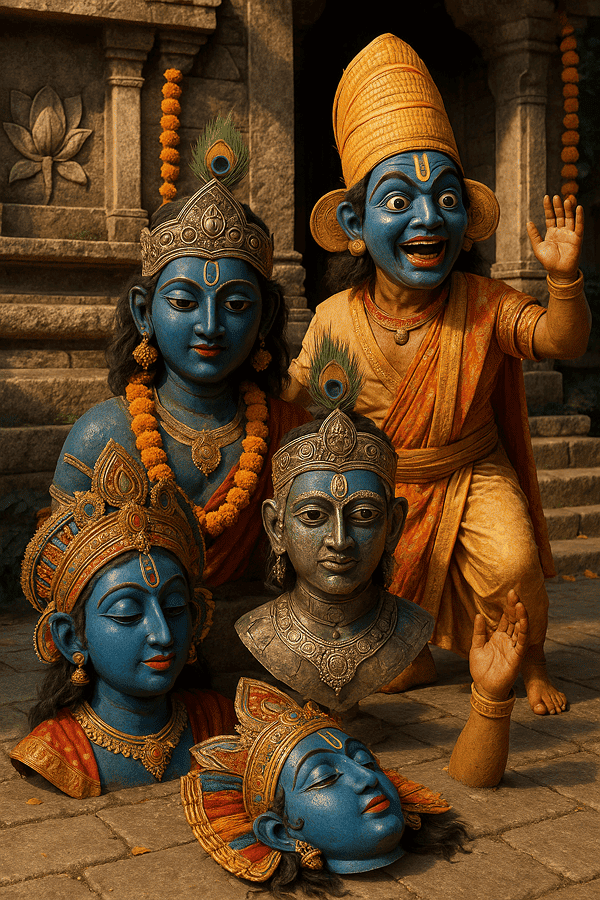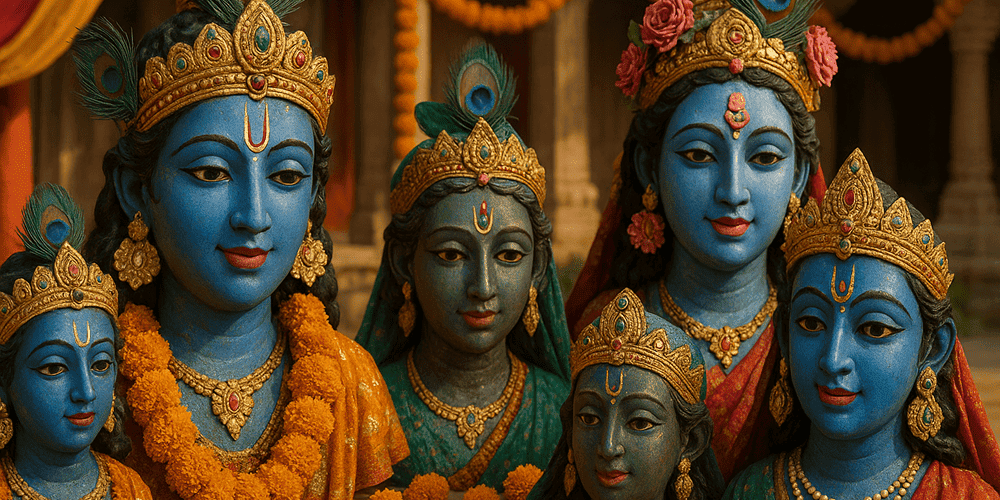Krishna Masks are among the most cherished and visually captivating artifacts in Indian religious and performing arts. These masks represent Lord Krishna, a central figure in Hindu mythology known for his divine playfulness, wisdom, and charisma. Krishna Masks are typically characterized by their striking blue or dark complexion, serene facial features, expressive eyes, and ornate decorations, including peacock feathers, jewelry, and floral motifs. Belonging mainly to the cultural regions of West Bengal, Odisha, Assam, and parts of South India, Krishna Masks have a rich tradition dating back several centuries and are integral to various ritual performances and festivals.
Historical Origins: The Evolution of Krishna Masks
The history of Krishna Masks is deeply tied to the evolution of devotional practices and folk theatre in India. The term “Krishna Mask” refers to any mask depicting Lord Krishna, whose stories are told in ancient scriptures such as the Mahabharata, the Bhagavata Purana, and countless regional tales. The use of masks in Krishna-centric rituals can be traced back to the medieval period, particularly in the rise of the Bhakti movement, which emphasized personal devotion and dramatic reenactments of Krishna’s life. Over time, the design and function of Krishna Masks evolved, influenced by regional art styles, temple traditions, and popular theatre forms such as Raslila and Krishnalila. Historical artifacts, temple carvings, and folk paintings provide evidence of the mask’s enduring role. Notably, the tradition of mask-making in India is also reflected in other regional forms such as Ravanahattha Masks, which highlight the diversity and creativity of Indian mask culture.
Cultural Significance and Symbolism: The Spiritual Meaning of Krishna Masks
Krishna Masks hold profound symbolic significance in Indian culture, serving as conduits for spiritual experience and cultural expression. In religious contexts, the mask is more than a representation — it is believed to become a vessel for the divine presence of Krishna during rituals and performances. The blue or dark complexion of the mask symbolizes Krishna’s transcendence, his connection to the infinite sky and ocean, and his role as the cosmic protector. Mythologically, Krishna is associated with music, love, and the playful subversion of social norms, all of which are reflected in the joyful, expressive features of the masks. Socially, Krishna Masks are used to unite communities during festivals such as Janmashtami, Holi, and Rasa Yatra, reinforcing shared values and collective devotion.
Materials and Craftsmanship: How Krishna Masks Are Made
Traditional Krishna Masks are crafted from materials such as papier-mâché, wood, clay, or metal, depending on regional preferences and intended use. The process begins with shaping the basic facial structure, followed by detailed modeling to create the eyes, lips, and ornaments. Artisans use natural pigments — particularly shades of blue, gold, and white — to paint the mask, often adding intricate designs, gilded accents, and embedded jewels. Tools like carving knives, brushes, and molds are commonly used. In Bengal and Odisha, masks may feature elaborate floral crowns and real peacock feathers, while in South India, they may include textile embellishments and silverwork. Each mask is unique, reflecting both the artisan’s skill and the local artistic tradition. The color symbolism is especially significant: blue for divinity, gold for prosperity, and green for vitality.
Functions and Use: Krishna Masks in Ritual, Theatre, and Festivals
Krishna Masks are primarily used in religious and theatrical performances that depict episodes from Krishna’s life, such as Raslila, Krishnalila, and other regional folk dramas. During these events, performers don the mask to embody Krishna, reenacting his playful adventures, battles, and divine miracles. The masks are also used in temple rituals, processions, and community celebrations, where they serve both as sacred objects and as tools for storytelling. Over time, the use of Krishna Masks has expanded to include educational programs, museum exhibitions, and contemporary dance and theatre productions. Their enduring popularity ensures that Krishna’s stories remain alive and accessible to new generations.
Regional Variations: Diversity of Krishna Masks in India
Krishna Masks exhibit significant regional diversity across India. In West Bengal, they are intricately painted with fine lines and adorned with floral garlands and peacock feathers. Odisha’s masks are often more sculptural, with detailed facial features and silver inlays. In Assam, Krishna Masks used in Sattriya performances emphasize dramatic expressions and are sometimes crafted from bamboo and natural fibers. South Indian versions may be larger, incorporating textile and metallic elements. Each region’s masks reflect local mythology, artistic conventions, and ritual needs. When compared to other Indian mask traditions, such as those of Ravanahattha Masks or Chhau Masks, Krishna Masks stand out for their focus on divine playfulness and spiritual charisma.

Famous Examples and Collections: Where to See Krishna Masks
Some of the most renowned Krishna Masks can be found in museums such as the Indian Museum in Kolkata, the Odisha State Museum, and the Assam State Museum. These institutions display masks from different periods and styles, alongside costumes, musical instruments, and folk art. Temple collections and private galleries also house rare and antique Krishna Masks, many of which are used in ongoing ritual performances. Online platforms like toddmasks.com offer curated galleries and educational resources for those interested in learning more about or collecting Krishna Masks.
Influence on Art and Culture: Krishna Masks in Modern Creativity
Krishna Masks have had a profound impact on Indian art, literature, music, and fashion. Their vibrant colors, stylized forms, and spiritual symbolism inspire contemporary painters, sculptors, and designers. Krishna Masks appear in literature and cinema, often representing themes of devotion, transformation, and the celebration of life. Modern dance and theatre productions frequently incorporate Krishna Masks, blending traditional and experimental forms. In fashion and design, the imagery of Krishna Masks is used to evoke Indian heritage and creativity. Their role in preserving and transmitting cultural values makes them a vital link between past and present.
Modern Status and Preservation: Keeping the Krishna Mask Tradition Alive
Today, the tradition of Krishna Mask-making is upheld by skilled artisans, cultural organizations, and temple communities across India. Workshops, festivals, and educational programs ensure the transmission of traditional techniques and encourage artistic innovation. Modern adaptations include the use of new materials, digital design, and collaborations with international artists, but the core values of craftsmanship and spiritual symbolism remain unchanged. Museums, NGOs, and academic institutions play a key role in documenting, exhibiting, and teaching about Krishna Masks, ensuring their continued relevance and appreciation.
Collecting and Acquisition: The Market for Krishna Masks
The market for Krishna Masks includes both antique and contemporary pieces, available in temple shops, folk art markets, museum stores, and online galleries such as toddmasks.com. Prices vary depending on age, craftsmanship, provenance, and ritual significance. Collectors are encouraged to seek documentation of authenticity, respect the ethical aspects of acquisition, and support local artisans. By valuing the cultural and spiritual context of Krishna Masks, collectors contribute to the preservation of an important aspect of Indian heritage.
